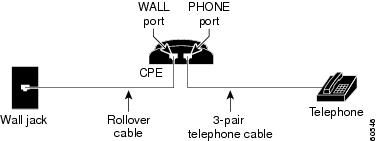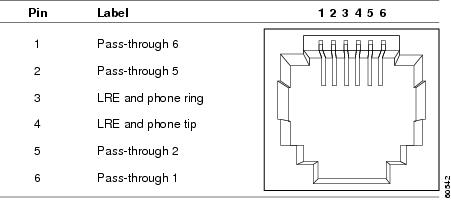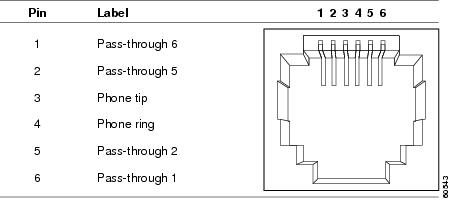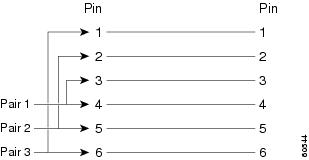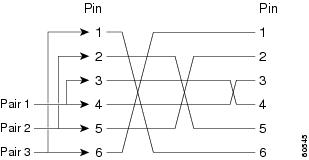 Feedback Feedback
|
Table Of Contents
Release Notes for the Cisco 575 LRE CPE
Clarifications and Corrections to Hardware Installation Guide
Interoperability Between Cisco 575 LRE CPE Devices and Telephones
Connecting to the CPE WALL and PHONE Ports
CPE WALL and CPE PHONE Port Pinouts
Pinouts Between the Wall Jack and CPE Ports
Identifying a Telephone Rollover Cable
Telephone Straight-Through and Rollover Cable Pinouts
Obtaining Technical Assistance
Contacting TAC by Using the Cisco TAC Website
Release Notes for the Cisco 575 LRE CPE
July 2001
This document provides corrections to the Cisco 575 LRE CPE Hardware Installation Guide and includes new information about connecting a telephone to the CPE. Use this document with the Cisco 575 LRE CPE Hardware Installation Guide.
Contents
This document has the following sections:
•
"Clarifications and Corrections to Hardware Installation Guide" section
•
"Pinouts Between the Wall Jack and CPE Ports" section
•
"Connectors and Cables" section
•
"Related Documentation" section
•
"Obtaining Technical Assistance" section
Clarifications and Corrections to Hardware Installation Guide
This section provides corrections to the Cisco 575 LRE CPE Hardware Installation Guide.
Interoperability Between Cisco 575 LRE CPE Devices and Telephones
Cisco Long-Reach Ethernet (LRE) products are designed to share lines with analog, integrated services digital network (ISDN), and digital private branch exchange (PBX) switch telephones that use the 0 to 700 kHz frequency range. Due to the proprietary nature of digital PBX switches, some digital PBX switch services use frequencies above 700 kHz.
Note
Digital telephones connected to digital PBX switches that use frequencies above 700 kHz will not work when sharing a line with LRE signals. [CSCdu73260]
Connecting to the CPE WALL and PHONE Ports
The "Installation" chapter of the Cisco 575 LRE CPE Hardware Installation Guide describes connecting the CPE WALL port to a telephone wall jack by using a standard RJ-11 telephone cable. We recommend using a telephone cable that has a three-pair, rollover configuration. [CSCdu55940]
To connect the CPE PHONE port to your telephone, use the telephone cable supplied with your telephone. (See Figure 1.)
Figure 1 Wall Jack to Telephone Connection
CPE WALL and CPE PHONE Port Pinouts
Figure B-3 and Figure B-4 in the "Cables and Connectors" appendix of the Cisco 575 LRE CPE Hardware Installation Guide incorrectly describe the CPE pinouts for the WALL and PHONE ports. Figure 2 and Figure 3 show the correct pinouts. [CSCdu55948]
Figure 2 Correct CPE WALL Port Connector Pinouts
Note
Figure 2 pinouts are correct when you use a rollover cable between the wall jack and the CPE WALL port. For a complete list of pinouts between the wall jack and CPE, see Table 1.
Figure 3 Correct CPE PHONE Port Connector Pinouts
Note
Figure 3 pinouts are correct when you use a rollover cable between the wall jack and the CPE WALL port. For a complete list of pinouts between the wall jack and CPE, see Table 1.
Pinouts Between the Wall Jack and CPE Ports
Long-Reach Ethernet (LRE) operation only requires one wire pair (pins 3 and 4) to carry LRE traffic. Therefore, you can use one-, two-, or three-pair telephone cable. However, you must use two- or three-pair cable for telephones that carry power or other services.
Note
We recommend using three-pair telephone cable to connect a telephone to the CPE.
Some single-line or multiline telephones are sensitive to the polarity inversion between pins 3 and 4 of the CPE WALL port and the CPE PHONE port. In these cases, pay special attention to the CPE PHONE port pinouts. (See Table 1.)
.
Note
Pins 3 and 4 are crossed internally between the CPE WALL port and the CPE PHONE port. Installing a rollover cable between the wall jack and CPE WALL port corrects the polarity so that the tip and ring connections on the CPE PHONE port are the same as the wall jack pins.
Note
The CPE WALL port pins in Table 1 are correct when you use a rollover cable between the wall jack and the CPE WALL port and an ordinary (straight-through) telephone cord between the CPE PHONE port and the telephone.
Troubleshooting
Table 2 lists the problems that you might encounter and their solutions.
Table 2 Common Problems and Their Solutions
No connection to telephone
Incorrect or bad cable.
•
Incorrect or defective rollover or straight-through telephone cable.
•
A rollover cable was used when a straight-through cable was required or vice-versa.
•
Replace with a tested good cable.
•
For the correct pinouts and the proper use of rollover and straight-through telephone cables, see the "Telephone Straight-Through and Rollover Cable Pinouts" section.
•
Telephone is sensitive to polarity inversion.
•
Ensure that the CPE PHONE jack pinouts match the wall jack pinouts.
•
Telephone uses signals above 700 kHz.
•
Verify that telephone requires frequencies above 700 kHz. If so, there is no resolution. Contact the Cisco Technical Assistance Center (TAC).
Connectors and Cables
This section describes the CPE connectors and the cables that you use to connect the CPE to other devices.
Identifying a Telephone Rollover Cable
You can identify a telephone rollover cable by comparing the two RJ-21 connectors at each end of the cable. Hold the cable ends side-by-side, with the tab facing away from you. The wire connected to the pin on the outside of the left RJ-21 connector should be the same color as the wire connected to the point on the outside of the right RJ-21 connector. (See Figure 4.)
Figure 4 Identifying a Telephone Rollover Cable
Telephone Straight-Through and Rollover Cable Pinouts
The schematics of straight-through and rollover telephone cables are shown in Figure 5 and Figure 6.
Figure 5 Telephone Straight-Through Cable Schematic
Figure 6 Telephone Rollover Cable Schematic
Related Documentation
The following publications provide more information about the Cisco 575 LRE CPE, the Catalyst 2900 LRE XL switches, and the LRE switch software:
•
Cisco 575 LRE CPE Hardware Installation Guide
•
Release Notes for the Catalyst 2900 Series XL and Catalyst 3500 Series XL, Cisco IOS Release 12.0(5.4)WC(1)
•
Release Notes for the Catalyst 2900 LRE XL Switches
•
Catalyst 2900 Series XL and Catalyst 3500 Series XL Software Configuration Guide
•
Catalyst 2900 Series XL and Catalyst 3500 Series XL Command Reference
•
Catalyst 2900 Series XL Hardware Installation Guide
Obtaining Documentation
The following sections provide sources for obtaining documentation from Cisco Systems.
World Wide Web
You can access the most current Cisco documentation on the World Wide Web at the following sites:
•
http://www.cisco.com
•
http://www-china.cisco.com
•
http://www-europe.cisco.com
Cisco Documentation CD-ROM
Cisco documentation and additional literature are available in a CD-ROM package, which ships with your product. The Cisco Documentation CD-ROM is updated monthly and may be more current than printed documentation. The CD-ROM package is available as a single unit or as an annual subscription.
Ordering Documentation
Cisco documentation is available in the following ways:
•
Registered Cisco Direct Customers can order Cisco Product documentation from the Networking Products MarketPlace:
http://www.cisco.com/cgi-bin/order/order_root.pl
•
Registered Cisco.com users can order the Documentation CD-ROM through the online Subscription Store:
http://www.cisco.com/go/subscription
•
Nonregistered Cisco.com users can order documentation through a local account representative by calling Cisco corporate headquarters (California, USA) at 408 526-7208 or, in North America, by calling 800 553-NETS(6387).
Documentation Feedback
If you are reading Cisco product documentation on the World Wide Web, you can submit technical comments electronically. Click Feedback in the toolbar and select Documentation. After you complete the form, click Submit to send it to Cisco.
You can e-mail your comments to bug-doc@cisco.com.
To submit your comments by mail, for your convenience many documents contain a response card behind the front cover. Otherwise, you can mail your comments to the following address:
Cisco Systems, Inc.
Document Resource Connection
170 West Tasman Drive
San Jose, CA 95134-9883We appreciate your comments.
Obtaining Technical Assistance
Cisco provides Cisco.com as a starting point for all technical assistance. Customers and partners can obtain documentation, troubleshooting tips, and sample configurations from online tools. For Cisco.com registered users, additional troubleshooting tools are available from the TAC website.
Cisco.com
Cisco.com is the foundation of a suite of interactive, networked services that provides immediate, open access to Cisco information and resources at anytime, from anywhere in the world. This highly integrated Internet application is a powerful, easy-to-use tool for doing business with Cisco.
Cisco.com provides a broad range of features and services to help customers and partners streamline business processes and improve productivity. Through Cisco.com, you can find information about Cisco and our networking solutions, services, and programs. In addition, you can resolve technical issues with online technical support, download and test software packages, and order Cisco learning materials and merchandise. Valuable online skill assessment, training, and certification programs are also available.
Customers and partners can self-register on Cisco.com to obtain additional personalized information and services. Registered users can order products, check on the status of an order, access technical support, and view benefits specific to their relationships with Cisco.
To access Cisco.com, go to the following website:
http://www.cisco.com
Technical Assistance Center
The Cisco TAC website is available to all customers who need technical assistance with a Cisco product or technology that is under warranty or covered by a maintenance contract.
Contacting TAC by Using the Cisco TAC Website
If you have a priority level 3 (P3) or priority level 4 (P4) problem, contact TAC by going to the TAC website:
http://www.cisco.com/tac
P3 and P4 level problems are defined as follows:
•
P3—Your network performance is degraded. Network functionality is noticeably impaired, but most business operations continue.
•
P4—You need information or assistance on Cisco product capabilities, product installation, or basic product configuration.
In each of the above cases, use the Cisco TAC website to quickly find answers to your questions.
To register for Cisco.com, go to the following website:
http://www.cisco.com/register/
If you cannot resolve your technical issue by using the TAC online resources, Cisco.com registered users can open a case online by using the TAC Case Open tool at the following website:
http://www.cisco.com/tac/caseopen
Contacting TAC by Telephone
If you have a priority level 1(P1) or priority level 2 (P2) problem, contact TAC by telephone and immediately open a case. To obtain a directory of toll-free numbers for your country, go to the following website:
http://www.cisco.com/warp/public/687/Directory/DirTAC.shtml
P1 and P2 level problems are defined as follows:
•
P1—Your production network is down, causing a critical impact to business operations if service is not restored quickly. No workaround is available.
•
P2—Your production network is severely degraded, affecting significant aspects of your business operations. No workaround is available.
This document is to be used in conjunction with the documents listed in the "Related Documentation" section.
AccessPath, AtmDirector, Browse with Me, CCIP, CCSI, CD-PAC, CiscoLink, the Cisco Powered Network logo, Cisco Systems Networking Academy, the Cisco Systems Networking Academy logo, Fast Step, Follow Me Browsing, FormShare, FrameShare, GigaStack, IGX, Internet Quotient, IP/VC, iQ Breakthrough, iQ Expertise, iQ FastTrack, the iQ Logo, iQ Net Readiness Scorecard, MGX, the Networkers logo, Packet, RateMUX, ScriptBuilder, ScriptShare, SlideCast, SMARTnet, TransPath, Unity, Voice LAN, Wavelength Router, and WebViewer are trademarks of Cisco Systems, Inc.; Changing the Way We Work, Live, Play, and Learn, Discover All That's Possible, and Empowering the Internet Generation, are service marks of Cisco Systems, Inc.; and Aironet, ASIST, BPX, Catalyst, CCDA, CCDP, CCIE, CCNA, CCNP, Cisco, the Cisco Certified Internetwork Expert logo, Cisco IOS, the Cisco IOS logo, Cisco Systems, Cisco Systems Capital, the Cisco Systems logo, Enterprise/Solver, EtherChannel, EtherSwitch, FastHub, FastSwitch, IOS, IP/TV, LightStream, MICA, Network Registrar, PIX, Post-Routing, Pre-Routing, Registrar, StrataView Plus, Stratm, SwitchProbe, TeleRouter, and VCO are registered trademarks of Cisco Systems, Inc. and/or its affiliates in the U.S. and certain other countries.
All other trademarks mentioned in this document or Web site are the property of their respective owners. The use of the word partner does not imply a partnership relationship between Cisco and any other company. (0106R)
Copyright © 2001, Cisco Systems, Inc.
All rights reserved.

